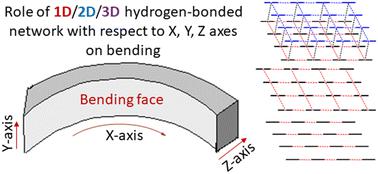当前位置:
X-MOL 学术
›
CrystEngComm
›
论文详情
Our official English website, www.x-mol.net, welcomes your
feedback! (Note: you will need to create a separate account there.)
The role of dimensionality and direction of hydrogen-bonded networks in the mechanical flexibility of organic crystals
CrystEngComm ( IF 2.6 ) Pub Date : 2023-08-29 , DOI: 10.1039/d3ce00681f Binoy K. Saha 1 , Sunirban Das 2 , Ragima V. P. Veluthaparambath 1
CrystEngComm ( IF 2.6 ) Pub Date : 2023-08-29 , DOI: 10.1039/d3ce00681f Binoy K. Saha 1 , Sunirban Das 2 , Ragima V. P. Veluthaparambath 1
Affiliation

|
The role of directionality and dimensionality of hydrogen-bonded networks in the flexibility of organic crystals has been discussed in this highlight. Only those flexible organic crystals whose hydrogen-bonded networks are 1D, 2D, or 3D in their crystal structures have been considered and only conventional strong hydrogen bonds such as O–H⋯O, O–H⋯N, N–H⋯O, N–H⋯N, etc. are considered. 37 cases of plastic/elastic bending and one case of shearing crystals have been analyzed. How the crystal grows with respect to the unit cell dimension and the hydrogen-bonded networks has also been taken into account in this analysis. As hydrogen-bonded synthons are the main and most reliable element in crystal engineering while designing molecules to obtain crystals with desired properties, we anticipate that this knowledge, discussed here, would be helpful in designing flexible crystals with desired properties.
中文翻译:

氢键网络的维数和方向在有机晶体机械柔性中的作用
本重点讨论了氢键网络的方向性和维度在有机晶体灵活性中的作用。仅考虑了晶体结构中氢键网络为 1D、2D 或 3D 的柔性有机晶体,并且仅考虑了传统的强氢键,例如 O-H⋯O、O-H⋯N、N-H⋯O、 N–H⋯N等被考虑。分析了 37 种塑性/弹性弯曲情况和 1 种剪切晶体情况。该分析还考虑了晶体如何相对于晶胞尺寸和氢键网络生长。由于氢键合成子是晶体工程中主要且最可靠的元素,同时设计分子以获得具有所需特性的晶体,我们预计这里讨论的这些知识将有助于设计具有所需特性的柔性晶体。
更新日期:2023-08-29
中文翻译:

氢键网络的维数和方向在有机晶体机械柔性中的作用
本重点讨论了氢键网络的方向性和维度在有机晶体灵活性中的作用。仅考虑了晶体结构中氢键网络为 1D、2D 或 3D 的柔性有机晶体,并且仅考虑了传统的强氢键,例如 O-H⋯O、O-H⋯N、N-H⋯O、 N–H⋯N等被考虑。分析了 37 种塑性/弹性弯曲情况和 1 种剪切晶体情况。该分析还考虑了晶体如何相对于晶胞尺寸和氢键网络生长。由于氢键合成子是晶体工程中主要且最可靠的元素,同时设计分子以获得具有所需特性的晶体,我们预计这里讨论的这些知识将有助于设计具有所需特性的柔性晶体。





















































 京公网安备 11010802027423号
京公网安备 11010802027423号